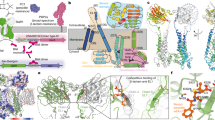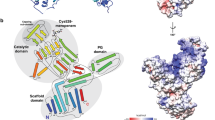Abstract
Streptomyces cacaoi β-lactamase genes are controlled by two regulators named blaA and blaB. Whereas BlaA has been identified as a LysR-type activator, the function of BlaB is still unknown. Its primary structure is similar to that of the serine penicillin-recognizing enzymes (PREs). Indeed, the SXXK and KTG motifs are perfectly conserved in BlaB, whereas the common SXN element found in PREs is replaced by a SDG motif. Site-directed mutations were introduced in these motifs and they all disturb β-lactamase regulation. A water-soluble form of BlaB was also overexpressed in the Streptomyces lividans TK24 cytoplasm and purified. To elucidate the activity of BlaB, several compounds recognized by PREs were tested. BlaB could be acylated by some of them, and it can therefore be considered as a penicillin-binding protein. BlaB is devoid of β-lactamase, D-aminopeptidase, DD-carboxypeptidase or thiolesterase activity.
Similar content being viewed by others
Author information
Authors and Affiliations
Corresponding author
Additional information
Received 13 January 2003; received after revision 9 April 2003; accepted 11 April 2003
Rights and permissions
About this article
Cite this article
Raskin, C., Gérard, C., Donfut, S. et al. BlaB, a protein involved in the regulation of Streptomyces cacaoi β-lactamases, is a penicillin-binding protein. CMLS, Cell. Mol. Life Sci. 60, 1460–1469 (2003). https://doi.org/10.1007/s00018-003-3008-9
Issue Date:
DOI: https://doi.org/10.1007/s00018-003-3008-9




